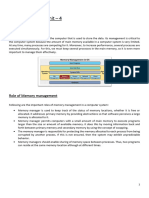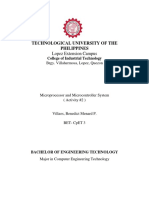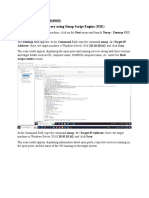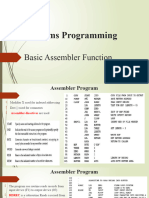Rweryguihiojop
Rweryguihiojop
Uploaded by
Soumyaprakash PaniCopyright:
Available Formats
Rweryguihiojop
Rweryguihiojop
Uploaded by
Soumyaprakash PaniOriginal Description:
Original Title
Copyright
Available Formats
Share this document
Did you find this document useful?
Is this content inappropriate?
Copyright:
Available Formats
Rweryguihiojop
Rweryguihiojop
Uploaded by
Soumyaprakash PaniCopyright:
Available Formats
Comment
Memory Organization
The main purpose of a computer system is to execute programs. These programs,
together with the data they access, must be in main memory (at least partially)
during execution. To improve both the utilization of CPU and the speed of its
response to its users, the computer must keep several processes in memory.
There are many different memory-management schemes. Since main memory is
usually too small to accommodate all the data and programs permanently, the
computer system must provide secondary storage to back-up main memory.
Address mapping and translation
Most systems allow a user process to reside in any part of the physical memory.
(http://gradestack.com/mainsite/home)
Explore (/mainsite/explorecourse)
Memory Organization
Although the address space of the computer starts at 00000, the first address of
the user process does not need to be 00000. In most cases, a user program goes
through several steps before being executed. Addresses may be represented in
different ways during these steps. Addresses in the source program are generally
symbolic. A compiler typically binds these symbolic addresses to relocatable
addresses. The linkage editor or loader will in turn bind these relocatable
addresses to absolute addresses. Each binding is a mapping from one address
space to another. The addresses are translated using the relocation registers.
As in the diagram, the binding of instructions and data to memory can be done at
any step along the way:
Compile time: If it is known at compile time where the process will reside
in memory, then absolute code can be generated. For example, if it is
known a priori that a user process resides starting at location R, then the
generated compiler code will start at that location and extend up from
there. If, at some later time, the starting location changes, then it will be
necessary to recompile this code.
Load time: If it is not known at compile time where the process will reside
in memory, then the compiler must generate relocatable code. In this
case, final binding is delayed until load time. If the starting address
changes, we need only to reload the user code to incorporate this
changed value.
Execution time: If the process can be moved during its execution from
one memory segment to another, then binding must be delayed until run
rime.
Comment
Comment
Logical and physical addresses
An address generated by the CPU is commonly referred to as a logical address,
whereas an address seen by the memory unit, i.e., the one loaded into the
memory address register of the memory, is called physical address. The logical
address space may also be referred to as virtual address space. Now, since as
user we only see the logical address, but the system works with physical
addresses, some mapping must be done to allow correct working. This mapping
is done by the memory-management unit (MMU).
Base and Limit Registers
Base and limit registers are special registers in the system which are used by
MMU to convert logical addresses to physical addresses. Base register keep the
starting address of physical memory where the program resides where as the
limit register keeps the length of the program. These registers allow protecting
the OS code and data as well as a simpler model of executable (user) code. The
purpose of having base-limit register pairs is to address specific sub regions of
the memory unit.
Comment
Comment
Logical Address MMU Physical Address
The limitation of the base-limit register pair scheme of memory partitioning is
that the OS code has to fill in the actual memory address values in the registers
when a program is loaded. This implies that for every program to be loaded, the
OS has to manipulate certain references to memory addresses in the program.
Additional hardware support of physical address generation using a combination
of base register and the logical address generated by the CPU allows dynamic
relocation without the CPU overheads of physical address computation.
Memory management unit
A memory management unit (MMU) is a computer hardware component
responsible for handling accesses to memory requested by the central
processing unit (CPU). Its functions include translation of virtual addresses to
physical addresses, memory protection etc.
The MMU uses a base register also called relocation register. The value in this
register is added to the logical address, to get the physical address. That means,
depending on the value of the relocation register, the logical address is relocated
to its actual physical location.
Memory partitioning
The main memory must accommodate both the operating system and the various
user processes. The memory is usually divided into two partitions, one for the
resident operating system, and one for the user processes. If single partition
scheme is used, then we need to protect the operating-system code and data
from changes by the user processes and also protect the user processes from one
another. This can be done by loading the relocation and limit registers with the
correct values as part of the context switch.
For multiple partitions, one of the simplest methods is to divide memory into
several fixed-size partitions. Each partition may contain exactly one process.
Thus, the degree of multiprogramming is bound by the number of partitions. When
a partition is free, a process is selected from the input queue and is loaded into
the free partition. When the process terminates, the partition becomes available
for another process. Other method is to consider all memory as one large block, a
hole. When a process arrives and needs memory, we search for a hole large
enough for this process. If we find one, we allocate only as much memory as is
needed, keeping the rest available to satisfy future requests. Thus after some
time, there is at any time a set of holes, of various sizes, scattered throughout
memory. The operating system keeps a table indicating which parts of memory
are available and which are occupied.
The set of holes is searched to determine which hole is best to allocate. First-fit,
best-fit, and worst-fit are the most common strategies used to select a free hole
from the set of available holes.
Comment
Comment
Fragmentation
By partitioning the memory and allocating them using various strategies, the
memory is fragmented. Fragmentation can be internal and external. When fixed
size partitions are used, the process may or may not be the same size as the
partition. Thus, some amount of memory is left unused leading to internal
fragmentation.
When variable size partitions are used, problem of external fragmentation is
created as a lot of memory may still be available but since it is not contiguous, it
cannot be allotted to a process. The solution to the external fragmentation
problem is compaction. The goal is to shuffle the memory contents to place all
free memory together in one large block.
Previous
Deadlock
<
Next
Memory management techniques
>
Full Name
Email
Password
Contact Number
Account Already Exist?
Login Here (/web/login)
Facebook Connect
Create Account
mail us at contact@gradestack.com (mailto:contact@gradestack.com)
About Us (/mainsite/aboutus)
News (/mainsite/news)
Blog (/blog/)
Contact Us (/mainsite/contact)
Terms and Conditions (/mainsite/policy)
Developers (/mainsite/developer)
Publishers (/mainsite/publisher)
Please Register
f
or
You might also like
- Gitting Things Done - A Visual and Practical Guide To Git (Full Book)Document288 pagesGitting Things Done - A Visual and Practical Guide To Git (Full Book)Brass Roots MusicNo ratings yet
- Main Memory ManagementDocument7 pagesMain Memory ManagementpoojajadhavNo ratings yet
- Chapter-6 Memory ManagementDocument98 pagesChapter-6 Memory ManagementYasar KhatibNo ratings yet
- Osmodule IIIDocument23 pagesOsmodule IIISandipNo ratings yet
- Basic Hardware IssuesDocument18 pagesBasic Hardware IssuesRakesh PatilNo ratings yet
- OS Module IVDocument73 pagesOS Module IVsitsekharNo ratings yet
- Memory Management - PQDocument27 pagesMemory Management - PQSaurabh YadavNo ratings yet
- Process Address Space: Symbolic AddressesDocument10 pagesProcess Address Space: Symbolic AddressesManmeetNo ratings yet
- CS Oss 3Document82 pagesCS Oss 3cjjasmin3No ratings yet
- Memory Management in Operating System - GeeksforGeeksDocument18 pagesMemory Management in Operating System - GeeksforGeeksabubakarkhalid5864No ratings yet
- Os Memory ManagementDocument6 pagesOs Memory ManagementMd Omar FaruqNo ratings yet
- 3rd OsDocument5 pages3rd Osricara3986No ratings yet
- Os 3Document43 pagesOs 3Dhoni GamerNo ratings yet
- Os MM - 021727Document19 pagesOs MM - 021727Franck divinfranckNo ratings yet
- Unit IVDocument32 pagesUnit IVgalampriya9743No ratings yet
- 5.1 Main MemoryDocument68 pages5.1 Main Memoryritikagupta.3kNo ratings yet
- Chapter 3 Memory ManagementDocument20 pagesChapter 3 Memory Managementvugutsaruth38No ratings yet
- Topic Notes: Memory Management: Computer Science 322 Operating SystemsDocument25 pagesTopic Notes: Memory Management: Computer Science 322 Operating SystemsNeetika KatariaNo ratings yet
- ICS 143 - Principles of Operating SystemsDocument83 pagesICS 143 - Principles of Operating SystemsManoj SharmaNo ratings yet
- Memory Management in OSDocument30 pagesMemory Management in OSCherryNo ratings yet
- Unit 4 Part 1 Updated 1Document13 pagesUnit 4 Part 1 Updated 1Atharva ShasaneNo ratings yet
- 8 Memory ManagementDocument41 pages8 Memory ManagementPrajwal KandelNo ratings yet
- Memory ManagementDocument63 pagesMemory ManagementTheSpeedDealNo ratings yet
- Additional Course Material: Computer BasicsDocument9 pagesAdditional Course Material: Computer BasicskaviatchennaiNo ratings yet
- POS - Unit - IVDocument24 pagesPOS - Unit - IVkunduruishwarya30No ratings yet
- Important Questions and AnswersDocument18 pagesImportant Questions and Answerssa5212866No ratings yet
- Platform Technologies Module 5Document29 pagesPlatform Technologies Module 5Ronel “Ron” RotoniNo ratings yet
- What Is The Base Register and What Is The Limit Register?: SystemDocument9 pagesWhat Is The Base Register and What Is The Limit Register?: SystemGaby Mbugua75% (4)
- New OSY PPT - Unit 5.1Document25 pagesNew OSY PPT - Unit 5.1casexi3151No ratings yet
- Main MemoryDocument63 pagesMain MemoryNIDHINo ratings yet
- Memory ManagementDocument75 pagesMemory ManagementJong KookNo ratings yet
- Memory ManagementDocument8 pagesMemory Managementrecu12121No ratings yet
- Operating System - Memory Management: Process Address SpaceDocument21 pagesOperating System - Memory Management: Process Address SpaceMamathaNo ratings yet
- All Document Reader 1726040550514Document9 pagesAll Document Reader 1726040550514matetisantosh37No ratings yet
- Operating System AssignmentDocument6 pagesOperating System AssignmentBibhuti boraNo ratings yet
- Unit-5 Memory ManagementDocument46 pagesUnit-5 Memory ManagementPrajwal KandelNo ratings yet
- Os Unit - 4Document25 pagesOs Unit - 422wh1a1231No ratings yet
- Lecture 05Document50 pagesLecture 05browninasiaNo ratings yet
- Unit 4 NotesDocument36 pagesUnit 4 NotesHare Ram SinghNo ratings yet
- Operating Systems: Memory ManagementDocument19 pagesOperating Systems: Memory ManagementMukesh100% (3)
- Memory Management - Module 4Document38 pagesMemory Management - Module 4Saurabh YadavNo ratings yet
- Chapter 3 Memory Management Part 1 Main MemoryDocument75 pagesChapter 3 Memory Management Part 1 Main Memoryamanterefe99No ratings yet
- OS Unit IVDocument96 pagesOS Unit IVbala ramanNo ratings yet
- 7 Memory ManagementDocument57 pages7 Memory ManagementAdesh Kumar chaturvediNo ratings yet
- Unit 4 - Part 1Document138 pagesUnit 4 - Part 130508csiotNo ratings yet
- Presentation of OSDocument27 pagesPresentation of OSUmer NaveedNo ratings yet
- 3.1. Operating System - Memory ManagementDocument9 pages3.1. Operating System - Memory ManagementBulbula KumedaNo ratings yet
- OS Chapt 3 (2015)Document15 pagesOS Chapt 3 (2015)kasutaye192No ratings yet
- Memory ManagementDocument33 pagesMemory ManagementsonnetnargideNo ratings yet
- Operating System - Memory Management: Process Address SpaceDocument10 pagesOperating System - Memory Management: Process Address SpaceNelson RajaNo ratings yet
- OSPPTDocument52 pagesOSPPTshanigondal126No ratings yet
- Unit-4 (Os)Document15 pagesUnit-4 (Os)modirishi928No ratings yet
- Chapter 8 Main Memory: Bernard Chen Spring 2007Document51 pagesChapter 8 Main Memory: Bernard Chen Spring 2007dolfinblablaNo ratings yet
- Ch. 3 Lecture 1 - 3 PDFDocument83 pagesCh. 3 Lecture 1 - 3 PDFmikiasNo ratings yet
- Computer OrganisationDocument17 pagesComputer Organisationkijanavictor96No ratings yet
- Unit 5 Memory ManagementDocument20 pagesUnit 5 Memory ManagementlmmincrNo ratings yet
- Unit 4aDocument104 pagesUnit 4aKoushik ThummalaNo ratings yet
- Technological University of The Philippines: Lopez Extension CampusDocument4 pagesTechnological University of The Philippines: Lopez Extension CampusbennieNo ratings yet
- Unit5 OsDocument20 pagesUnit5 Osईश्वर महालेNo ratings yet
- OS Module3.2 MemoryDocument65 pagesOS Module3.2 MemoryDavidNo ratings yet
- SAS Programming Guidelines Interview Questions You'll Most Likely Be AskedFrom EverandSAS Programming Guidelines Interview Questions You'll Most Likely Be AskedNo ratings yet
- Important News at A Glance For 2014 (April 2014) - BestguruDocument2 pagesImportant News at A Glance For 2014 (April 2014) - BestguruSoumyaprakash PaniNo ratings yet
- Calendar - Days For Dates: Day of The WeekDocument2 pagesCalendar - Days For Dates: Day of The WeekSoumyaprakash PaniNo ratings yet
- Use of AnDocument2 pagesUse of AnSoumyaprakash PaniNo ratings yet
- Study: Problems in Use of ArticlesDocument3 pagesStudy: Problems in Use of ArticlesSoumyaprakash PaniNo ratings yet
- 3q345fyijokpl (Document8 pages3q345fyijokpl (Soumyaprakash PaniNo ratings yet
- Square Roots and Cube RootsDocument4 pagesSquare Roots and Cube RootsSoumyaprakash PaniNo ratings yet
- Concept of Approximation: Explore (/mainsite/explorecourse)Document3 pagesConcept of Approximation: Explore (/mainsite/explorecourse)Soumyaprakash PaniNo ratings yet
- SrdtdyhfujbhknDocument5 pagesSrdtdyhfujbhknSoumyaprakash PaniNo ratings yet
- SdsttyyDocument3 pagesSdsttyySoumyaprakash PaniNo ratings yet
- FftyfygjhnkmlmDocument8 pagesFftyfygjhnkmlmSoumyaprakash PaniNo ratings yet
- Tdfferszbblk LDocument10 pagesTdfferszbblk LSoumyaprakash PaniNo ratings yet
- Some Computer Hardware DevicesDocument2 pagesSome Computer Hardware DevicesSoumyaprakash PaniNo ratings yet
- 6-Data Structures and Algorithms Mcqs With Answers PDF NotesDocument18 pages6-Data Structures and Algorithms Mcqs With Answers PDF NotesMuhammad UsmanNo ratings yet
- CarPlay Wired-To-Wireless Adapters Comparison - Wired-To-Wireless CarPlay AdaptersDocument1 pageCarPlay Wired-To-Wireless Adapters Comparison - Wired-To-Wireless CarPlay Adapterscharlieost32No ratings yet
- IEEE Quiz App Using Android StudioDocument5 pagesIEEE Quiz App Using Android StudioPratiksha100% (1)
- Resume John Michael Ma LongDocument1 pageResume John Michael Ma LongKPO PHILNo ratings yet
- Grade7 Q0 W4 PerformMensuration for-STUDENTDocument32 pagesGrade7 Q0 W4 PerformMensuration for-STUDENTMICHAEL USTARENo ratings yet
- SQL ExamplesDocument4 pagesSQL ExamplesCRONOQUILL OFFICIALNo ratings yet
- Lab2 3.2,4,6.1 HOD401Document39 pagesLab2 3.2,4,6.1 HOD401Nguyen Giang Nam (K16 HCM)No ratings yet
- Hitachi EH Series PLC - ENDocument6 pagesHitachi EH Series PLC - ENEta CoursesNo ratings yet
- ADC2Document189 pagesADC2chiranjib_kNo ratings yet
- Winter 23 Model AnswerDocument21 pagesWinter 23 Model Answerᴀʙʜɪsʜᴇᴋ ᴄʜɪɴᴄʜᴏʟᴇNo ratings yet
- Wireless Transmission Report-1Document10 pagesWireless Transmission Report-1آمنة علي عبد الرزاقNo ratings yet
- Software Processes: ©ian Sommerville 2004 Slide 1Document50 pagesSoftware Processes: ©ian Sommerville 2004 Slide 1Cecep Kurnia SastradiprajaNo ratings yet
- PEGA Common Production Issues - 1Document3 pagesPEGA Common Production Issues - 1vijayprpcNo ratings yet
- Hexa Litepaper Hexa Protocol: What Is DLT?Document7 pagesHexa Litepaper Hexa Protocol: What Is DLT?Akpoke Shedrack100% (1)
- Mohammed Shafi: Work ExperienceDocument3 pagesMohammed Shafi: Work ExperienceDhanashree HiwaseNo ratings yet
- 04 Assimpler1Document28 pages04 Assimpler1ahmedNo ratings yet
- IServer 2017 Admin Guide - System Administrator Training v0.3Document74 pagesIServer 2017 Admin Guide - System Administrator Training v0.3Tom KakanowskiNo ratings yet
- Faraz SourceDocument13 pagesFaraz SourceHarshit AroraNo ratings yet
- Pundit Lab Adds Site Functionality To The Leading Ultrasonic Test Instrument For ConcreteDocument4 pagesPundit Lab Adds Site Functionality To The Leading Ultrasonic Test Instrument For ConcreteJabranYounasNo ratings yet
- NM-911 Rev0.4 Schematic: R17M-P1-50 R17M-P1-70 Intel Whiskey Processor With DDR4 + PCHDocument99 pagesNM-911 Rev0.4 Schematic: R17M-P1-50 R17M-P1-70 Intel Whiskey Processor With DDR4 + PCHjonathan hernandezNo ratings yet
- Introduction To Computer ApplicationDocument56 pagesIntroduction To Computer ApplicationKrithika K MuralidharanNo ratings yet
- Vivid S6 BT10 Dicom ConfDocument155 pagesVivid S6 BT10 Dicom ConfDavid Uribe SalamancaNo ratings yet
- Pembagian Paket UKK UpdateDocument5 pagesPembagian Paket UKK Updaterenapunya2292No ratings yet
- Computer Networks-Lab: Hareem Aslam Hareem - Aslam@pucit - Edu.pkDocument22 pagesComputer Networks-Lab: Hareem Aslam Hareem - Aslam@pucit - Edu.pkHareem AslamNo ratings yet
- FALLSEM2021-22 CSE2006 ETH VL2021220104015 Reference Material I 02-09-2021 Module 1 8086 Instruction SetsDocument80 pagesFALLSEM2021-22 CSE2006 ETH VL2021220104015 Reference Material I 02-09-2021 Module 1 8086 Instruction SetsAdarsh MishraNo ratings yet
- 1 Non-Uniform Quantizer - PDFDocument5 pages1 Non-Uniform Quantizer - PDFABHISHEK BNo ratings yet
- Question 1: Your AnswerDocument26 pagesQuestion 1: Your AnswerMarwa Benayed100% (1)
- Classification of ComputerDocument11 pagesClassification of ComputerAjay KumarNo ratings yet
- Performing Matrix Vector Multiplication Approximation Using Crossbar Arrays of Resistive Memory DevicesDocument12 pagesPerforming Matrix Vector Multiplication Approximation Using Crossbar Arrays of Resistive Memory DevicesMohammed Siyad BNo ratings yet





































































































